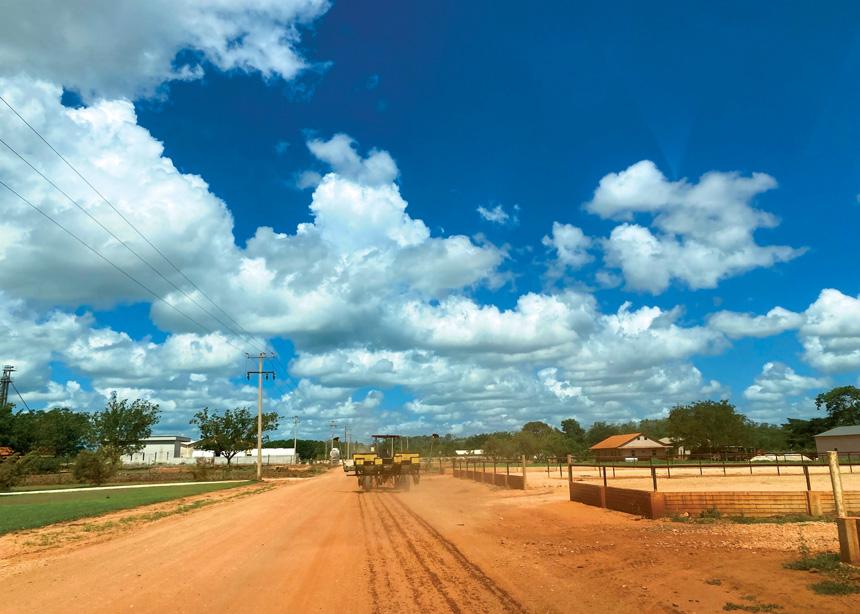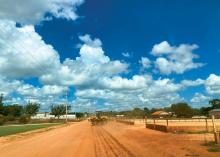At 9 a.m., it was already hot and humid in Hopelchén, a small city in the Yucatán peninsula. A collective of Maya farmers had gathered in the shaded courtyard outside the home where we were staying. We could hear laughter and chatter over the wall as we returned from our morning walk. As we stepped through the gate, the group welcomed us into their circle, offering plates of food made from corn, beans and chaya.
We were there as members of the Coalition to Dismantle the Doctrine of Discovery, a group of Mennonites from the U.S. and Canada who work to repair the harms of colonization and promote Indigenous self-determination.
Five years ago, the Maya collective invited the coalition to join them in addressing concerns related to their colony Mennonite neighbours. They wanted to identify shared interests and seek mutual wellbeing. A series of campaigns has followed.
As the meeting began, the Maya gave thanks to the land, water and seeds that have sustained their lives for millennia.
They reflected on a question fundamental to their existence: What do seeds mean? They said seeds are culture and spirituality, life and death. Seeds are memory, medicine and resistance. Seeds, like land and water, are not property nor commodities, but a sacred community to which the Maya belong.
The name of the collective—Colectivo In Laak Le Ixiimó—means “our sibling, corn.”
They gather because of their commitment to saving native seeds. “I’m saving seeds for life, for my children,” one person said.
The group is concerned because Maya ancestral territory is threatened by the agricultural practices of neighbouring Mennonite colonies. Since the 1980s, the spread of Mennonite colonies across Campeche state in southwestern Mexico has increased deforestation and contributed to the contamination and depletion of groundwater. The widespread use of hybrid corn and genetically modified soy is compromising the continuance of native seed varieties.
The collective members worry about their people’s future in the land.
Yet, they were clear they’re not fighting against the Mennonites but against extractive economic systems. These systems harm everyone, whether Maya or Mennonite. They hope for the shared flourishing of all who live in the land.
They asked us to help them clarify the interests, values and concerns of their Mennonite neighbours, in hopes of opening possibilities for conversations.
Anika joined the delegation as a student of Mennonite theology and environmental management, Lars as chair of the coalition’s Maya-Mennonite Solidarity Working Group. Tina is a fluent Low German speaker who facilitated connections with colonies.
Over six weeks in July and August of 2023, we listened to the stories of dozens of Maya and Mennonite farmers as we walked through fields and shared meals.
Don Eduardo and Doña Elena walked with us in fields where they have cultivated native corn, beans and squash for over 40 years. (Names have been changed in accordance with the agreed protocol between the coalition and the collective.) The forest to the east and west funneled a strong, hot wind that tugged at our hats and drew sweat off our skin. The summer had been unusually dry. The corn on their 12 hectares (30 acres) barely peeked through the soil.
On the northern horizon, pivot-irrigation systems stood over green, knee-high corn on 1,200 hectares (3,000 acres) owned by an absentee landholder. The corn was being grown for hybrid seed by the multinational crop science and pharmaceutical company Bayer. Mennonite farmers, including the one who rents the field south of Don Eduardo and Doña Elena’s land, buy this seed.
Last year, the couple lost a portion of their crop when the Mennonite farmer’s agrochemicals drifted across property lines.
Standing in Don Eduardo and Doña Elena’s field, the friction between histories, ecologies and political and economic forces was palpable. The market for domestic corn collapsed in the late 20th century with the arrival of imported U.S. and Canadian corn under NAFTA. The negotiations of this trade agreement also precipitated a series of major land reforms in Mexico.
As a result, many Maya farmers left their fields, and the region, in search of other work. Now, they rent or sell their land to other farmers, mostly Mennonites. The same trade liberalization and land reform policies that have pushed Maya from the land have made Campeche an attractive home for Mennonites from northern Mexico.
Starting in the 1920s, Mennonites who chafed at Canadian public schooling obligations moved to northern Mexico under a deal with a Mexican government eager to resettle a country destabilized by a recent revolution. These migrants’ grandparents had settled on Ojibway, Métis and Cree territory at the invitation of the Canadian government. Before that, fearing conscription and education reform, their ancestors had left Russia, the land to which earlier generations had migrated from Central and Western Europe at the promise of land and freedom.
In each Mennonite migration, the particular history of the land that received them was less important to them than what they believed God was doing through them. Clearing the land and its history, they set the stage for the drama of their faith: bearing witness to God’s faithfulness through productive, fruitful lives on the land, set apart from the world.
Showing us a chest his family brought from Russia, one Mennonite farmer recalled the process of clearing the land he now farms. “We wouldn’t be here if it wasn’t God’s will,” he said.
In Campeche, there are 17 Mennonite colonies, with at least two more in formation. Most of these colonies are structured around the church and the colony corporation. The corporation serves as gatekeeper of finance, seeds and agrochemical inputs. Because colony corporations only offer credit for the production of soy, sorghum and corn, few households can afford to experiment with other crops.
Mennonite farmers we spoke with said this system favours large landholders. Speaking in his farmhouse over faspa (a light evening meal), one farmer described the economic burdens he carried due to consecutive seasons of little rain. His debt was compounded by the cost related to his wife’s medical issues.
To manage these debts, he had rented an additional 81 hectares (200 acres)— an hour away by tractor—tripling his holdings. The risk was immense, but he felt compelled to take it.
Economic pressures had pushed him to set aside his experiments with alternative agricultural practices. Five years earlier, Maya activists had visited the colony to make a case for organic crops. Intrigued, he worked with them to design and build a machine that speeds the composting process for producing organic fertilizer on a large scale. He showed us how this fertilizer grew better corn and healthier fruit trees around his house.
Pest pressure had led most families to abandon home gardens long ago, but his family relished the beauty and flavour of their garden tomatoes. Better than anything they could buy, he said.
But the compost machine had sat unused for three years. He was deterred from continuing due to rising debt, the intensive labour required to produce the fertilizer and the lack of buy-in from other farmers.
He told us some farmers are interested in organic production but lack capital. “They’d have to go into debt to make it work, and they’re afraid,” he said.
This farmer remembers his Maya collaborators fondly. Though the composter sits idle, the attempt encourages our Maya partners.
“It’s not about Mennonites adopting Maya agroecological practices,” one member of the collective told us. They imagine a future in which Mennonites adapt their own practices to become more connected with the lives around them, while still reflecting their own particular social and theological context.
As we listened, we wondered whether accepting this invitation would require fundamental changes to Mennonite theological and social imagination. What would it take for each of us— Mennonites in many places—to hear this invitation from God through our scriptures and in our contexts: to see land, water and all life as part of a sacred community to which we belong?
How, we wondered, might we describe our relationship with seeds?
Back in the courtyard with the collective members, their discussion of all that seeds mean to them wound down. An elder spoke up: “We’re missing one important thing—fiestas!” Everyone laughed.
As the meeting ended, Doña Elena and another native seed guardian returned home to warm up the mill to grind corn. They would be throwing a quinceañera party soon, and there were tortillas to make.
A delegation from the Coalition to Dismantle the Doctrine of Discovery will return to Campeche in May 2024. To learn more, or support the work, click here.




Add new comment
Canadian Mennonite invites comments and encourages constructive discussion about our content. Actual full names (first and last) are required. Comments are moderated and may be edited. They will not appear online until approved and will be posted during business hours. Some comments may be reproduced in print.